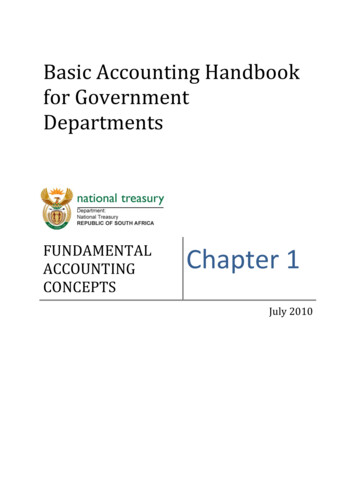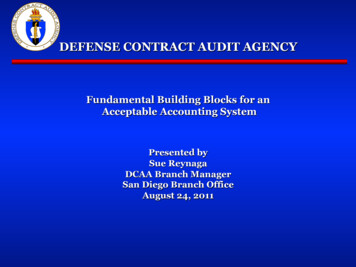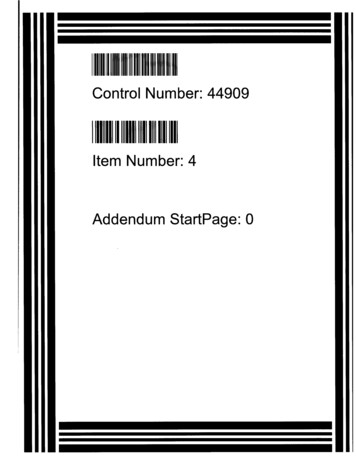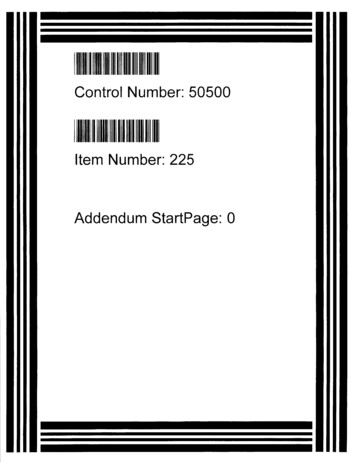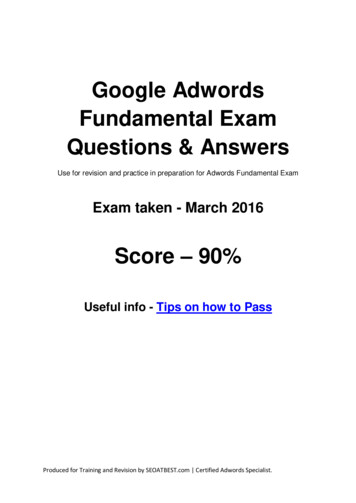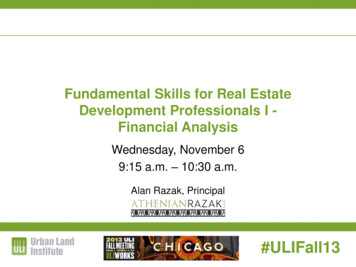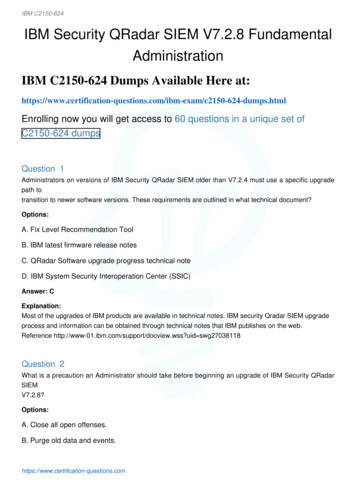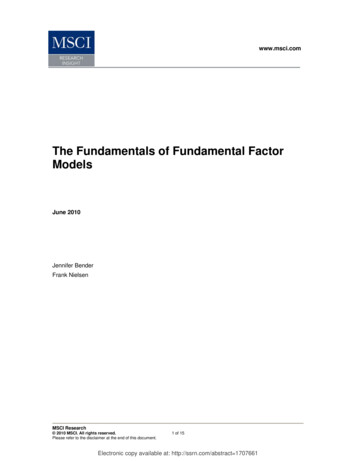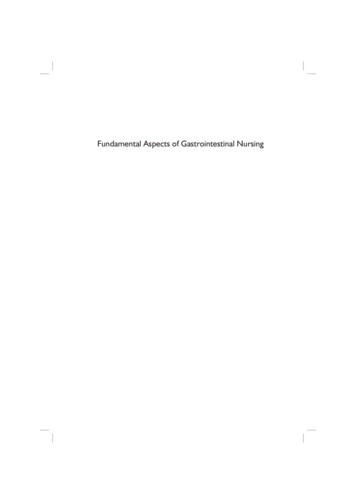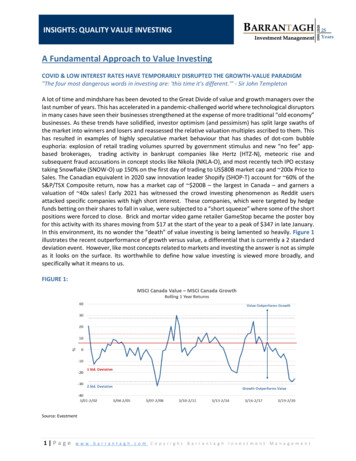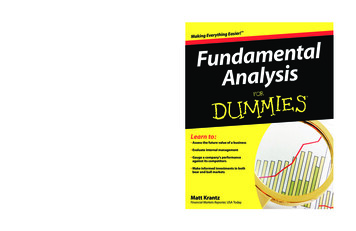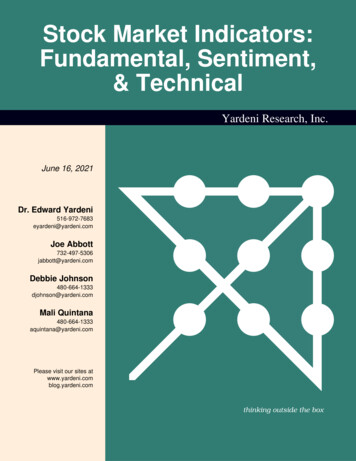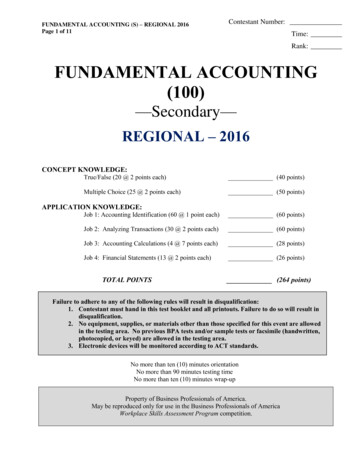
Transcription
FUNDAMENTAL ACCOUNTING (S) – REGIONAL 2016Page 1 of 11Contestant Number:Time:Rank:FUNDAMENTAL ACCOUNTING(100)—Secondary—REGIONAL – 2016CONCEPT KNOWLEDGE:True/False (20 @ 2 points each)(40 points)Multiple Choice (25 @ 2 points each)(50 points)APPLICATION KNOWLEDGE:Job 1: Accounting Identification (60 @ 1 point each)(60 points)Job 2: Analyzing Transactions (30 @ 2 points each)(60 points)Job 3: Accounting Calculations (4 @ 7 points each)(28 points)Job 4: Financial Statements (13 @ 2 points each)(26 points)TOTAL POINTS(264 points)Failure to adhere to any of the following rules will result in disqualification:1. Contestant must hand in this test booklet and all printouts. Failure to do so will result indisqualification.2. No equipment, supplies, or materials other than those specified for this event are allowedin the testing area. No previous BPA tests and/or sample tests or facsimile (handwritten,photocopied, or keyed) are allowed in the testing area.3. Electronic devices will be monitored according to ACT standards.No more than ten (10) minutes orientationNo more than 90 minutes testing timeNo more than ten (10) minutes wrap-upProperty of Business Professionals of America.May be reproduced only for use in the Business Professionals of AmericaWorkplace Skills Assessment Program competition.
FUNDAMENTAL ACCOUNTING (S) – REGIONAL 2016Page 2 of 11General InstructionsYou have been hired as a Financial Assistant and will be keeping the accounting records forProfessional Business Associates, located at 5454 Cleveland Avenue, Columbus, Ohio 43231.Professional Business Associates provides accounting and other financial services for clients. You willcomplete jobs for Professional Business Associates’ own accounting records, as well as for clients.You will have 90 minutes to complete your work. The test is divided into two parts: conceptknowledge and application of knowledge.Your name and/or school name should NOT appear on any work you submit for grading. Write yourcontestant number in the provided space. Staple all pages in order before you turn in your test.Assumptions to make when taking this assessment: Round all calculations to two decimals. Use 360 days for interest calculations.
FUNDAMENTAL ACCOUNTING (S) – REGIONAL 2016Page 3 of 11DEBITS AND CREDITS/True or FalseDirections: Read each statement and determine whether it is true or false. If using a Scantron sheetuse A for true and B for false. If writing on the test, use T for true and F for false.1.Whether a debit or credit increases or decreases an account’s balance depends on thetype of account.2.A debit can represent an increase or decrease to an account’s balance.3.Assets normally have a credit balance.4.A debit increases an asset account’s balance while a credit decreases an asset account’sbalance.5.The “right side” of an account’s structure is the credit side.6.A credit always increases an account’s balance.7.A debit increases an expense account’s balance while a credit reduces an expenseaccount’s balance.8.Debits and credits are the accounting terms used to identify the left and right sides of anaccount.9.Revenue accounts normally have a credit balance.10.Liability and Equity accounts normally have credit balances.11.A debit increases a liability account while a credit decreases a liability account.12.Expense and drawing accounts normally have a debit balance.13.Debits do not always have to equal credits.14.All permanent accounts have a normal balance that is either a debit balance or a creditbalance.15.The “left side” of an account represents the credit side.16.Contra asset accounts normally have debit balances.17.A debit always increases an account’s balance.18.Liability, equity, and revenue accounts normally have a debit balance.19.A debit decreases an expense account while a credit increases an expense account.20.A debit decreases a revenue account while a credit increases a revenue account.
FUNDAMENTAL ACCOUNTING (S) – REGIONAL 2016Page 4 of 11MULTIPLE CHOICEDirections: Identify the letter of the choice that best completes the statement or answers the question.1.Temporary capital accounts start each fiscal period witha. debit balances.b. credit balances.c. zero balances.d. both debit and credit balances.2.At the end of a fiscal period, the first closing entry will be to closea. expense accounts into the Income Summary account.b. the withdrawal account into the Capital account.c. revenue accounts into the Capital account.d. revenue accounts into the Income Summary account.3.If an account starts with the Number 4, it represents a(n)a. revenue account.b. expense account.c. capital account.d. liability account.4.Which of the following statements is true?a. The Income Summary account is an owner’s equity account.b. The Income Summary account has a normal debit balance.c. The Income Summary account is a permanent account.d. The Income Summary account is used throughout the accounting period.5.The financial statements of a business entitya. include the balance sheet, income statement, and income tax return.b. provide information about the profitability and financial position of the company.c. are the first step in the accounting process.d. are prepared for a fee by the Financial Accounting Standards Board.6.A balance sheet is designed to showa. how much a business is worth during the current fiscal period.b. the profitability of the business during the current fiscal period.c. the value of assets, liabilities, owner’s equity in the business on a particular date.d. the cost of replacing the assets and of paying off the liabilities at the end of thefiscal period.7.The process of transferring information from the journal to the individual generalledger accounts is calleda. journalizing.b. posting.c. transferring.d. closing.
FUNDAMENTAL ACCOUNTING (S) – REGIONAL 2016Page 5 of 118.Accounts that are continuous from one accounting period to the next and theirbalances are carried forward are referred to asa. fiscally continuous accounts.b. permanent accounts.c. signature accounts.d. temporary accounts.9.What two types of transactions increase owner’s equity?a. investments and withdrawalsb. investments and revenuec. investments and expensesd. investments and assets10.In accounting, the terms debit and credit indicate, respectively:a. increase and decreaseb. decrease and increasec. left and rightd. right and left11.The process of originally recording a business transaction in the accounting records istermeda. journalizing.b. footing.c. posting.d. balancing.12.If expenses exceed revenue during a given fiscal period,a. assets will decrease more than liabilities.b. owner’s equity will decrease more than assets.c. the Cash account will decrease.d. the Income Statement will show a net loss.13.The journal entry to adjust the Prepaid Insurance account isa. debit Prepaid Insurance; credit Insurance Expense.b. debit Insurance Expense; credit Prepaid Insurance.c. debit Income Summary; credit Prepaid Insurance.d. debit Insurance Expense; credit Income Summary.14.The journal entry to close the expense accounts isa. debit Income Summary; credit Owner’s Capital.b. debit each expense account; credit Income Summary.c. debit Income Summary for the total expenses; credit each expense account.d. none of the above.
FUNDAMENTAL ACCOUNTING (S) – REGIONAL 2016Page 6 of 1115.Which of the following accounts would not appear on the Post-Closing TrialBalance?a. Accounts Receivableb. Advertising Expensec. Accounts Payabled. J. Jones, Capital16.In the sequence of procedures performed during the accounting cycle, the financialstatements are prepareda. prior to preparing a work sheet.b. after completing the work sheet.c. after all posting is completed.d. after preparing a post-closing trial balance.17.Owner’s equity isa. the amount taken out of a business by the owner for personal use.b. the financial interest of the owner of a business.c. the amount the owner invested in the business.d. the revenues less the expenses.18.Which financial statement is a depiction of the fundamental accounting equation?a. Income Statementb. Statement of Owner’s Equityc. Balance Sheetd. Profit and Loss Statement19.The entry to transfer a net loss to the Capital account would includea. a debit to Capital and a credit to Cash.b. a debit to Drawing and a credit to Capital.c. a debit to Income Summary and a credit to Capital.d. a debit to Capital and a credit to Income Summary.20.The entry in a firm’s accounting records for a credit customer’s check that wasreturned by the bank marked “NSF” would includea. a debit to Miscellaneous Expense and a credit to Cash.b. a debit to Accounts Receivable and a credit to Cash.c. a debit to Cash and a credit to Miscellaneous Expense.d. a debit to Cash and a credit to Accounts Receivable.21.The most appropriate form of endorsement of a check for business purposes isa. the blank endorsement.b. the restrictive endorsement.c. the full endorsement.d. the special endorsement.
FUNDAMENTAL ACCOUNTING (S) – REGIONAL 2016Page 7 of 1122.Debits are used to recorda. increases in assets.b. increases in revenue.c. increases in owner’s equity.d. increases in liabilities.23.The total of the figures on the left side of a Cash account is 25,800. The total of thefigures on the right side is 14,100. The balance of this accounta. is 11,700 and would be recorded on the credit side of the account.b. is 11,700 and would be recorded on the debit side of the account.c. is 39,900 and would be recorded on the credit side of the account.d. is 39,900 and would be recorded on the debit side of the account.24.Which of the following accounts is not a permanent account?a. Cashb. Accounts Payablec. Salaries Expensed. Thomas Bernard, Capital25.The account used to record increases in owner’s equity from the sale of services isa. the revenue account.b. the cash account.c. the capital account.d. the drawing account.
FUNDAMENTAL ACCOUNTING (S) – REGIONAL 2016Page 8 of 11ACCOUNT IDENTIFICATIONDirections: For each account name below, indicate its classification, its normal balance side, and onwhich financial statement(s) the account appears. Use the appropriate abbreviations for your answers.ClassificationsLAOERE LiabilityAssetOwner’s EquityRevenueExpensesAccount NameAccounts PayableCashFee IncomeAccounts ReceivableB. John, CapitalAdvertising ExpenseIncome SummaryB. John, DrawingSuppliesNotes PayablePrepaid AdvertisingLandSalaries ExpenseOffice EquipmentPrepaid InsuranceNormal Balance SideDR CR N DebitCreditNeitherFinancial StatementsBSISN Balance SheetIncome StatementNoneTemporary/Permanent AccountP PermanentT raryFinancialStatement(s)
FUNDAMENTAL ACCOUNTING (S) – REGIONAL 2016Page 9 of 11ANALYZING TRANSACTIONSDirections: Professional Business Associates opened for business on July 1, 2015. The company usesthe general ledger accounts listed below. Analyze each transaction into its debit and credit parts andplace the letter code of the account titles to be debited or credited on the line under the appropriatecolumn. You may use more than two accounts for each transaction.A.B.C.D.E.F.G.CashPetty CashAccounts ReceivableSuppliesOffice EquipmentAccounts PayableL. Lyons, CapitalH.I.J.K.L.M.L. Lyons, DrawingFees IncomeAdvertising ExpenseMiscellaneous ExpenseRent ExpenseUtilities ExpenseDEBIT1.L. Lyons, the owner, invested 68,000 cashin the business.2.Issued a check for 1,300 to pay the rent for July.3.Bought office equipment for 22,000. IssuedCheck 102 for 10,000; balance is due in 60 days.4.Purchased supplies for 420 cash.5.Returned damaged supplies and received a cashrefund of 120.6.Performed services for 2,550 on credit.7.Purchased supplies for 310 on credit.8.Paid 225 for a newspaper advertisement.9.Received 4,200 for services performed.10.Paid 175 for utilities.11.Issued a check to owner for 800 for personal expenses.12.Paid 100 to establish a petty cash fund.13.Record bank service charge of 6.14.Paid cash to replenish the petty cash fund, 28:Supplies, 12; Miscellaneous Expense, 16.15.Paid 3,600 on account to a creditor.CREDIT
FUNDAMENTAL ACCOUNTING (S) – REGIONAL 2016Page 10 of 11ACCOUNTING CALCULATIONS1.The beginning owner’s capital is 46,000. Net income for the period is 15,500. The ownerwithdrew 24,800 cash from the business and made an additional investment of 5,000.How much is the owner’s capital balance at the end of the period?1.2.During the month of February, Professional Business Associates had the followingtransactions involving revenue and expenses:Paid 100 for phone billProvided services to clients for 1,400Paid salaries of 675 to employeesPaid 1,150 for computer repairsProvided services on account totaling 2,200Did Professional Business Associates have a net income or loss for the month? Howmuch?2a.2b.3.Professional Business Associates bank statement shows a balance of 15,500. There areoutstanding checks totaling 1,600, an outstanding deposit of 2,400, and a bank servicecharge of 20. What would be the bank statement balance after the accountant hasperformed a bank reconciliation?3.4.Professional Business Associates treats the purchase of supplies as an asset until the end ofthe fiscal period when it adjusts the account. The balance in the Supplies account at the endof the fiscal period is 3,400 DR. The person in charge of the supply room has sent a memostating that at the end of the fiscal period there is 980 worth of supplies. Calculate theamount of the adjustment to bring the Supplies account up-to-date and show the accountsyou would debit and credit.4a.4b. Account Debited4c. Account Credited
FUNDAMENTAL ACCOUNTING (S) – REGIONAL 2016Page 11 of 11FINANCIAL STATEMENTSDirections: Calculate the missing information on each of the financial statements below. Fill in themissing labels.Professional Business AssociatesIncome StatementMonth Ended, January 31, 2016Revenue:Fees IncomeTotal RevenueExpense
18. Which financial statement is a depiction of the fundamental accounting equation? a. Income Statement b. Statement of Owner’s Equity c. Balance Sheet d. Profit and Loss Statement 19. The entry to transfer a net loss to the Capital account would include a. a debit to Capital and a credit to Cash. b. a debit to Drawing and a credit to Capital.
